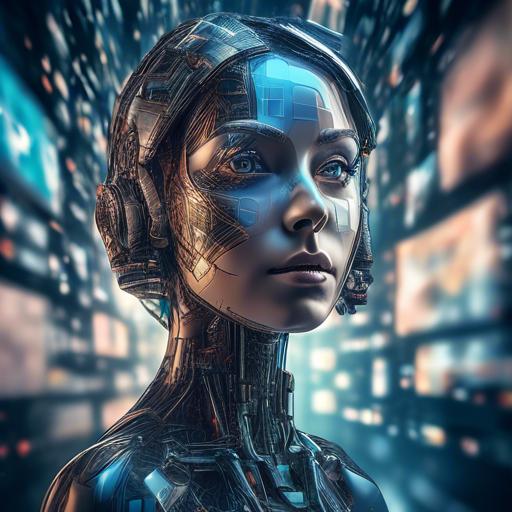In a world where data is as abundant as the air we breathe, the ability to distill it into digestible, insightful visuals has never been more crucial. Imagine transforming sprawling spreadsheets and dense databases into captivating masterpieces with just a few clicks—like turning lead into gold, only better because it’s real. Welcome to the revolutionary realm of AI for generating infographics and data visualizations. This isn’t just a leap forward in technology; it’s a quantum jump in how we understand and communicate complex information. Whether you are a seasoned data analyst, a marketer striving to tell a powerful story, or someone simply curious about enhancing your presentations, you’re about to discover tools that will change the way you visualize data forever. Buckle up as we embark on an enlightening journey through pixels, patterns, and possibilities—with AI as our trusted guide.
Table of Contents
- Unlocking Creativity with AI-Driven Infographics
- Harnessing Machine Learning for Stunning Data Visualizations
- Essential Tools and Software for AI-Powered Graphics
- Ensuring Accuracy and Integrity in Automated Infographic Creation
- Customization and Personalization: Tailoring Visuals with AI
- Empowering Non-Designers: Simplifying Complex Data with AI
- Future Trends: The Next Frontier in AI-Generated Infographics
- Closing Remarks
Unlocking Creativity with AI-Driven Infographics
Imagine transforming raw data into visually compelling stories—no graphic design degree required. With the advent of AI-driven tools, anyone can create stunning infographics that not only grab attention but also enhance the understanding of complex information.
Artificial Intelligence makes the process almost magical. These powerful algorithms analyze data sets, identify patterns, and recommend the most effective ways to visualize the information. Whether you’re a marketer, educator, or business analyst, AI can help you to:
- Choose the Right Chart Type: Say goodbye to the guesswork. AI can suggest whether a bar chart, pie chart, or scatter plot will best represent your data.
- Optimize Design Elements: From color schemes to font choices, AI offers design tips that align with best practices and ensure your infographic is visually appealing.
- Automate Data Updates: Keep your visualizations up-to-date effortlessly. AI tools can fetch and integrate real-time data, ensuring your infographics are always relevant.
One particularly fascinating feature is the ability to use AI to customize visual stories based on your audience’s preferences and behavior. Imagine dynamically adjusting your infographics for different viewer demographics or interest groups, enhancing engagement and comprehension. The future is here, and it’s extremely user-friendly.
| Feature | Benefit |
|---|---|
| Smart Chart Suggestions | Eliminates guesswork, enhances accuracy |
| Design Automation | Ensures visually appealing layouts |
| Real-Time Data Integration | Keeps information current |
| Audience Personalization | Boosts engagement levels |
In the dynamic world of digital communication, AI-driven infographics bring a new edge to storytelling. They not only save time but elevate the quality of visual narratives, making it easier than ever to communicate complex data in an engaging and understandable way. With AI at your fingertips, the boundaries of creativity are limitless.
Harnessing Machine Learning for Stunning Data Visualizations
In today’s data-driven world, presenting complex datasets in a visually appealing manner has become paramount. By leveraging the transformative power of Machine Learning, the capacity to create stunning and informative data visualizations has opened new frontiers. These intelligent systems can analyze vast amounts of data and identify patterns that might be overlooked by humans, allowing for **insightful, dynamic, and aesthetically pleasing representations**.
One significant advantage is the ability to automate the selection of visualization types that best represent the data. For instance, Machine Learning algorithms can determine whether a particular dataset is best viewed as a bar chart, scatter plot, or heat map, thereby saving time and ensuring accuracy. Here are a few benefits of this approach:
- **Intuition in selection:** Algorithms can suggest the most effective visualization form.
- **Dynamic updates:** Visuals can adapt in real-time as new data is fed into the system.
- **Custom styling:** Easily apply consistent and visually harmonious themes.
Moreover, Machine Learning enables the generation of **interactive infographics** that enhance user engagement by allowing individuals to explore the data themselves. Interactive elements such as hover effects, clickable regions, and drill-down capabilities can be seamlessly integrated, making information more accessible and engaging. This functionality is pivotal for creating infographics that are not just informative but also immersive.
Consider the following example of a Machine Learning-enhanced data table for a marketing campaign analysis:
| Metric | Q1 | Q2 | Q3 | Q4 |
|---|---|---|---|---|
| Ad Impressions | 1M | 2.5M | 3M | 2M |
| Click-Through Rate | 2% | 2.5% | 2.8% | 2.1% |
| Conversions | 500 | 1,200 | 1,500 | 1,000 |
This table not only summarizes data effectively but, when paired with Machine Learning, can dynamically display insights, trends, and projections based on historical data.
Furthermore, these advanced capabilities are not restricted to developers and data scientists. Many **user-friendly tools** powered by Machine Learning now exist, enabling anyone to craft professional-grade visualizations. Platforms like Tableau, Power BI, and even some WordPress plugins have integrated Machine Learning to democratize data analysis and visualization, making it accessible to a broader audience.
In essence, integrating Machine Learning with data visualization tools fosters a more intuitive, interactive, and insightful experience. By transforming raw data into captivating visual stories, these technologies empower users to make more informed decisions and convey their findings persuasively.
Essential Tools and Software for AI-Powered Graphics
Embarking on creating stunning infographics and data visualizations with AI requires the right set of tools and software. These digital aids will not only streamline your workflow but also enhance the quality and impact of your graphical outputs. Here is a curated list of indispensable resources:
- Adobe Illustrator CC: A quintessential tool for graphic designers, Adobe Illustrator CC’s vector capabilities beautifully complement AI-powered data rendering. Its precision and versatility make it a staple for detailed and scalable graphics.
- Tableau: Known for its prowess in data visualization, Tableau integrates seamlessly with AI tools to generate insightful and interactive visualizations. Its user-friendly interface ensures that even those with minimal experience can craft professional-grade graphics.
- DALL-E by OpenAI: Dive into the world of generative design with DALL-E. This AI tool excels at converting textual descriptions straight into high-quality images, opening endless possibilities for visual creativity and customization.
Of course, software isn’t the whole story. Pairing these with robust **hardware** is crucial for a smooth experience. Here’s a quick comparison of some recommended setups:
| Hardware | Processor | Memory | Graphics |
|---|---|---|---|
| MacBook Pro | M1 Pro | 16GB | Integrated 10-core GPU |
| Surface Studio | Intel i7 | 32GB | NVIDIA GTX 1070 |
| Custom PC | AMD Ryzen 9 | 64GB | NVIDIA RTX 3080 |
enhancing your toolset with plugins and extensions can significantly elevate your workflow. Consider incorporating the following:
- Canva AI: Simplify your design process with Canva’s intuitive interface and AI-driven suggestions. Perfect for quick, compelling visuals tailored to your branding needs.
- ChartBlocks: Specializing in custom chart creation, ChartBlocks uses AI to automate the generation of complex data visualizations, enabling you to focus on storytelling.
- Snappa: For those needing rapid and professional results, Snappa combines ease of use with AI-enhanced features, offering a plethora of templates and customization options.
These tools and software options create a potent arsenal for any designer aiming to produce top-tier infographics and data visualizations. Experiment with combinations to find what suits your unique style and requirements best.
Ensuring Accuracy and Integrity in Automated Infographic Creation
Crafting infographics and data visualizations through AI can be a game changer, but maintaining the accuracy and integrity of the information is paramount. Ensuring that the data portrayed is reliable requires a multi-step approach involving data validation, algorithmic transparency, and constant monitoring.
First and foremost, **data validation** is essential. Before incorporating any dataset into an infographic, it’s critical to verify its source and authenticity. AI systems should be programmed to cross-check data across multiple reputable sources to ensure it’s both current and accurate. This minimizes the risk of disseminating misinformation.
- **Source Verification**: Cross-referencing data from trusted databases and websites.
- **Timestamp Check**: Ensuring the data is up-to-date and relevant.
- **Consistency Analysis**: Comparing data points to detect anomalies or inconsistencies.
Algorithmic transparency is another cornerstone. Understanding how the AI processes data to create visual elements fosters trust. Developers should provide clear documentation outlining their algorithms, detailing how data is interpreted and visually represented. This transparency allows users to grasp the methodology behind the visuals, ensuring clarity and reliability.
**User Education** plays a crucial role in maintaining the integrity of data visualizations. Educating users on how to interpret these AI-generated infographics can lead to more informed decisions. Simple instructions or tooltips integrated within the visuals can guide users to understand the context and relevance of the displayed data.
| Action | Purpose |
|---|---|
| Verify Data Sources | Ensure authenticity |
| Timestamp Validation | Keep data relevant |
| Algorithm Documentation | Foster transparency |
Additionally, **regular updates and monitoring** of AI systems are crucial to maintaining data integrity. Automating the process doesn’t eliminate the need for human oversight. Periodic reviews of the AI’s performance and updates to its algorithms are necessary to adapt to evolving data trends and sources.
Customization and Personalization: Tailoring Visuals with AI
In today’s dynamic landscape, leveraging AI for visual customization and personalization can turn mundane data into compelling narratives. Imagine the potential of AI algorithms that not only process vast amounts of data but also craft personalized visual stories. This isn’t just a vision of the future; it’s happening now, enabling more engaging and relevant infographics and data visualizations.
One of the key features of AI-driven customization is the ability to adapt visuals to specific audiences. **Personalized color schemes**, tailor-made layouts, and **responsive design elements** ensure that each viewer experiences the content in a way that’s most meaningful to them. Think of it as having a designer that’s always on-call, fine-tuning each graphic to meet the unique preferences of every user.
Consider the added value of **interactive infographics** where users can input their own data parameters and watch the visuals transform before their eyes. This level of interaction not only enhances the user experience but also fosters a deeper understanding of the presented information. AI tools can facilitate this customization seamlessly, offering a hands-on approach to data analysis and visualization.
Below is an example of how AI can personalize a dataset for different sectors:
| Sector | Color Palette | Visualization Type |
|---|---|---|
| Healthcare | Calming Blues and Greens | Heatmaps |
| Finance | Sleek Blacks and Golds | Line Charts and Bar Graphs |
| Education | Bright Primaries | Pie Charts and Infographics |
AI doesn’t just help in visualizing data more effectively; it enables users to connect with the data on a personal level. This kind of **human-centered design** driven by intelligent algorithms ensures that the information is not only accessible but also memorable. As we move forward, the integration of AI in customizing data visuals will undoubtedly become a staple for businesses and educators alike, refining the way we communicate complex information.
Empowering Non-Designers: Simplifying Complex Data with AI
Imagine having the ability to transform a mundane spreadsheet into a stunning visual narrative with just a few clicks. This isn’t a distant dream but a present-day reality, thanks to Artificial Intelligence. **Non-designers** can now effortlessly generate infographics and data visualizations that not only communicate information effectively but also captivate the audience’s attention.
- User-friendly interfaces: Many AI-driven tools come with drag-and-drop features and customizable templates, making it easier for anyone to create professional-quality visuals.
- Automated design suggestions: These tools analyze the data to suggest the best types of visualizations, ensuring that the information is represented in the most impactful way.
- Customization options: Users can tweak colors, fonts, and layouts, giving them the flexibility to align the visuals with their brand guidelines.
Consider the diversity of data visualization needs in various sectors. From corporate reports to educational materials and marketing campaigns, there’s an AI-driven solution suited for every purpose. Let’s take a closer look at how AI is serving different industries:
| Industry | Use Case | AI Tool Feature |
|---|---|---|
| Marketing | Customer Segmentation Analysis | Real-time Data Sync |
| Education | Interactive Learning Materials | Dynamic Templates |
| Healthcare | Patient Data Reporting | Data Privacy Controls |
By leveraging AI, non-designers can also quickly iterate on their designs based on feedback. Imagine presenting an initial infographic to a team, receiving input, and updating the design in minutes rather than hours. This **agility** opens up new possibilities for real-time decision-making and continuous improvement.
Artificial Intelligence doesn’t just democratize design; it empowers users to harness the full potential of their data. It bridges the gap between complex datasets and visually appealing, easily comprehensible reports. So here’s to a future where everyone can become a data storytelling powerhouse, irrespective of their design skills.
Future Trends: The Next Frontier in AI-Generated Infographics
- One of the most anticipated advancements is the evolution of **AI personalization**. As algorithms become more sophisticated, they will be able to tailor infographics and data visualizations to individual users’ preferences and comprehension levels, enhancing both understanding and engagement.
- **Interactive elements** are set to revolutionize the landscape. Instead of static images, expect infographics to become dynamic, offering animation, clickable elements, and real-time data updates that can be accessed across various devices seamlessly.
- AI’s integration with **natural language processing (NLP)** will enable the automatic generation of narrative insights, turning complex datasets into compelling stories that are easily digestible. This will be particularly valuable for users who aren’t experts in data analysis but need to draw meaningful conclusions from their data.
In addition, **sustainability in design** will become a significant focus. With increasing awareness of digital pollution and energy usage, AI will optimize infographics and visualizations to be more energy-efficient, ensuring they are as eco-friendly as they are informative.
Looking towards **inclusive design**, AI will play a pivotal role in creating visuals that are accessible to all users, including those with disabilities. Features like adjustable color contrasts, scalable text, and alternative text descriptions will become standard, making data visualization a universal language.
| Trend | Impact |
|---|---|
| Personalization | Increased User Engagement |
| Interactive Elements | Enhanced User Experience |
| NLP Integration | Automated Insight Generation |
| Sustainable Design | Eco-friendly Visuals |
| Inclusive Design | Universal Accessibility |
Moreover, the integration of **augmented reality (AR)** and **virtual reality (VR)** technologies will offer immersive ways to present and interact with data. Imagine wearing AR glasses and seeing infographics overlay your physical environment, bringing data to life in unprecedented ways.
**collaborative platforms** powered by AI will enable teams to co-create and edit visual content in real-time, fostering a more collaborative and efficient workflow. This will not only save time but also bridge the gap between data analysts and non-technical stakeholders.
Closing Remarks
As technology continues to advance at an exponential rate, the possibilities for creating visually stunning and informative infographics and data visualizations with AI are truly endless. From simplifying complex data sets to engaging audiences with dynamic visuals, the power of AI in this field is undeniable. So don’t hesitate to explore the exciting world of AI-generated infographics and data visualizations – the future of data representation is here, and the possibilities are as vast as your imagination. Embrace the power of AI and let your creativity soar!































